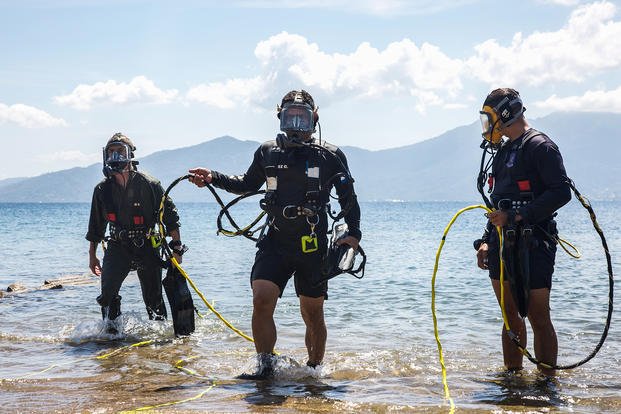When preparing for any military selection program, there are two specific phases you have to emphasize in your training.
Phase one is qualifying for the training by acing the physical screening test (PST), which consists of a 500-yard swim, push-ups, sit-ups, pull-ups and a 1.5-mile run (Navy diver, SWCC, SEAL, EOD, air rescue).
Phase two is preparing your body to get through the training. Your journey and emphasis will be based on your strengths and weaknesses. Endurance athletes will need to add more weight training. Strength/power athletes will need to do more running, swimming and calisthenics.
Here is an email from a recruit making his own workouts to prepare for the Navy diving program, but he’s got more to do than just preparing for the PST:
Hi, Stew. I'm working my way into training calisthenics because I want to increase my pull-ups, push-ups and sit-ups for the Navy Diver MOS and training. I need to also work on my cardio, as I am coming from a powerlifting background. My PST needs help, so I am making changes to my plan to increase my deadlifts/squats/overhead presses/bench press to more 8-15 rep ranges. Any advice on this is greatly appreciated.
Here is my schedule:
Monday: Swim & calisthenics & stretching
Tuesday: Run & weights
Wednesday: Swim & calisthenics & stretching
Thursday: Run & weights
Friday: Swim & calisthenics & stretching
Saturday: Light run or no run
Sunday: Rest
P.S.: How many pull-ups do you think I'll be able to get in a year of proper training? I'm in the 170 lbs., 6' range.
To prepare to get to and through selection training, you need to first focus on your weaknesses. I would not do workouts with weights in them for now; you need to focus more on cardio (run/swim), water comfort/techniques and muscle stamina. Your workouts should look like elements of the PST every other day, along with lower-body workouts (calisthenics, speed running, swimming) on the days in between.
So, instead of swimming every other day, I would focus on swimming every day. If you can handle daily running (progressively), I would try to run short but fast distances and goal pace workouts daily as well. Or replace them with non-impact cardio when needed. Your swim workouts should be tough every other day, accumulating 1,000- to 1,500-meter distances, along with easy tread workouts and technique swims (with fins, without fins, treading).
Where most go wrong with weight and calisthenics mixed
If you are going to add weights into the mix, do the same muscle groups on the same day. For instance, pull-ups can be coupled with pull-downs, rows, biceps curls and other pulling activities. The last thing you want to do is a high-repetition pull-up and push-up workout on Monday and then add in pulldowns, overhead press, bench press and rows on the following day -- only to repeat the same thing on Wednesday.
Your body needs to recover from high-volume calisthenics, just like it does from heavy weight training. Give it 48 hours before doing the same muscle groups again. Otherwise, you may not recover fully, train sore and see very slow progress over long periods of time.
You can use the background in strength to help you have great force production on land when running and in the water when swimming (pulling/kicking), especially with fins. However, for calisthenics like pull-ups, your strength will take you only so far.
Your first few pull-ups are a product of strength. Your 15-20+ pull-ups are a product of muscle stamina. Training to turn a strength exercise into an endurance exercise is going to get you 20+ pull-ups. At 170 pounds, you are the perfect weight to do 20+ pull-ups easily in a relatively short time (4-6 months), depending on where you start today.
There is nothing wrong with the training regimen you describe above, but it is not designed to help you master the PST. Nor is it designed to help you with the challenging aspects of training -- long swims, long tread workouts, high-rep calisthenics and running.
Eventually, your PST scores will be good enough to join the Navy and go to boot camp. Then after some deconditioning of boot camp, you will attend the diver prep course, which is challenging with many treading workouts, tests and underwater swim workouts. The ability to handle those workouts will help you get through training.
Check out Classic military PST training week as it includes more swimming, which you need, as well as more calisthenics and running to help with turning a strength/power athlete into more of a well-rounded, total tactical athlete.
See video discussion of the Classic Week of Military Special Ops PST Training.
Stew Smith is a former Navy SEAL and fitness author certified as a Strength and Conditioning Specialist (CSCS) with the National Strength and Conditioning Association. Visit his Fitness eBook store if you’re looking to start a workout program to create a healthy lifestyle. Send your fitness questions to stew@stewsmith.com.
Want to Learn More About Military Life?
Whether you're thinking of joining the military, looking for fitness and basic training tips, or keeping up with military life and benefits, Military.com has you covered. Subscribe to Military.com to have military news, updates and resources delivered directly to your inbox.
















